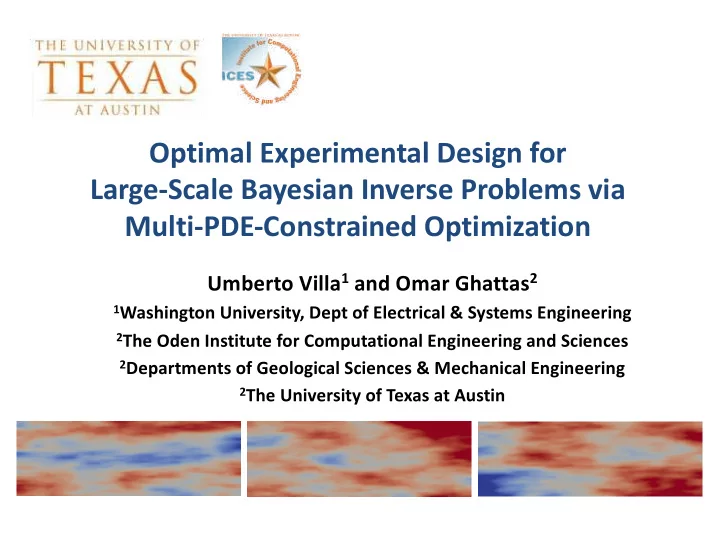

Optimal Experimental Design for Large-Scale Bayesian Inverse Problems via Multi-PDE-Constrained Optimization Umberto Villa 1 and Omar Ghattas 2 1 Washington University, Dept of Electrical & Systems Engineering 2 The Oden Institute for Computational Engineering and Sciences 2 Departments of Geological Sciences & Mechanical Engineering 2 The University of Texas at Austin
Motivation PDE models (and other) often depend on some uncertain input • parameters (fields) , whose values cannot be directly measured Bayesian inversion seeks to estimate the parameters and quantify the • uncertainty in the inversion, given observations of the outputs But for many problems, data acquisition is very expensive ; how do we • choose optimal experiments? – what is measured, where, and how often; which experiments to run, etc. Optimal experimental design (OED): find optimal data acquisition • strategy to minimize the uncertainty in the inferred parameters or maximize the information gained about the model Significant challenges : • – the parameter to be inferred is often a spatially correlated field – leads to high dimensional parameter space after discretization – the forward model is often expensive to solve (PDEs) – OED problem may have combinatorial complexity
Bayesian inversion for basal friction field in Antarctica InSAR-based ice surface velocity observations Inferred mean of basal friction field Reconstructed ice surface velocity field (based on Inferred uncertainty in basal friction field (standard inferred mean of basal friction field) deviation of Laplace approx of posterior of log basal friction) Joint work with Tobin Isaac (Georgia Tech), Noemi Petra (UC-Merced), Georg Stadler (NYU)
Bayesian global seismic inversion Joint work with Tan Bui-Thanh (UT Austin), Carsten Burstedde (Bonn), Georg Stadler (NYU), Lucas Wilcox (Naval Postgraduate School)
Bayesian poroelastic inversion for management of subsurface fluid injection Use observations (InSAR, GPS) of surface deformation induced by either wastewater injection or production of reservoir or aquifer, in addition to well pressure measurements, to infer subsurface permeability and elastic properties. Forward predict and then ultimately optimize injection or extraction processes to avoid induced seismicity or preserve reservoir integrity. Joint work with Amal Alghamdi, Ann Chen, Marc Hesse, Georg Stadler
Calibration of reduced models using DNS “data”: Which DNS experiments to run? Turbulence/reduced chemical mechanism model for turbulent combustion, calibrated using DNS data (w/ Bob Moser, Todd Oliver, Umberto Villa, Peng Chen, UT Austin) Inference of a mesoscopic nonlocal Cahn-Hilliard model parameters of block copolymers from ”DNS” molecular dynamics simulations and X-ray scattering experiments (w/Frank Alexander (Brookhaven), Tinsley Oden, Karen Willcox (UT Austin), Danial Faghihi (Buffalo))
Goals Devise scalable & efficient algorithms for OED problems governed by Bayesian inverse problems that are in turn governed by forward PDE models with uncertain parameter fields [ an outer loop around an outer loop ] • “Scalable” means the cost, measured in # of PDE solves , is independent of the parameter ( m ), data ( y ), and experimental design ( w ) dimensions • Efficient means the constant is “small” (difficult to achieve)
Recommend
More recommend